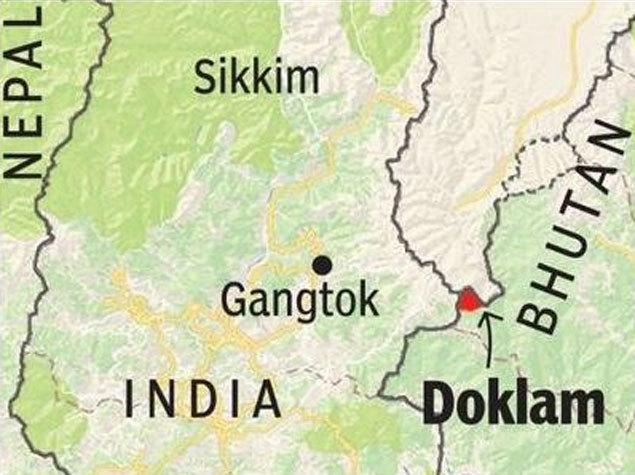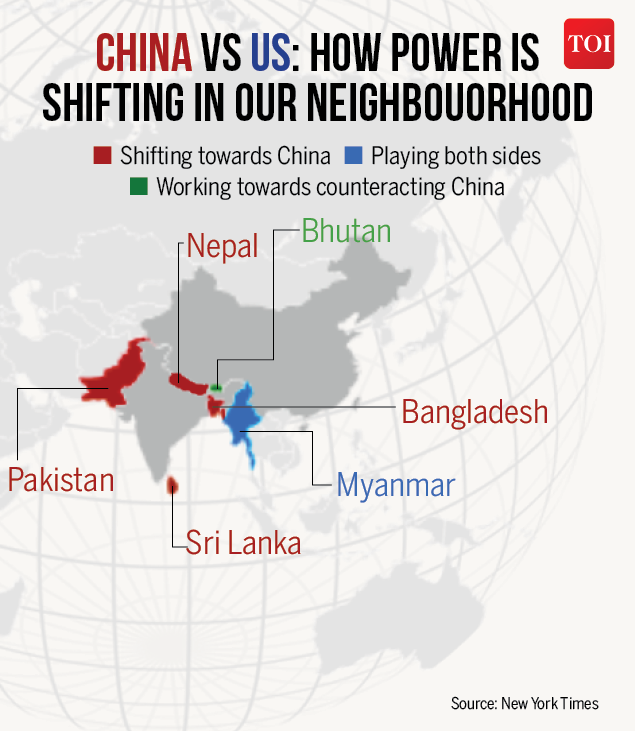Concerned over the growing Chinese presence in India’s neighbourhood, the Modi government has hiked its financial aid for the 2018-19 financial year beginning April to some countries.
While India is making inroads through the aid route, China, in turn is adopting a more capitalist approach and has made significant investments in the region. Determined to spread its presence abroad to protect its interests, evident in the establishment of foreign military bases, China is now also undertaking projects in almost all south Asian countries,
To combat China’s aggressive investments, India, in turn, has upped its aid to its neighbours and is focusing on being more efficient in implementation of its own development projects .

Aid to Bhutan and Nepal are at the top of the government’s list in terms of the financial assistance it will provide. Notably, aid to Nepal has increased to Rs 650 crore, a 73% increase from the previous year allocation. India’s aid to Nepal in 2017-18 financial year stood at Rs 375 crore.
However, it isn’t Nepal that is receiving the maximum aid. Instead, the largest allocation has yet again been kept for Bhutan at Rs 1,813 crore, which is part of the five-year commitment to help the royal government build hydro-electric projects at Punatsangchhu, and Mangdechhu among other infrastructure works.

A parliamentary committee report on external affairs tabled last week noted, “China is making serious headway in infrastructure projects in our neighbourhood. Specifying the strategy devised to counter increasing Chinese presence in our backyard, the government is committed to advancing its development partnership with Bhutan and Nepal, as per their priorities,” the report said.
“The allocation of funds under to Bhutan and Nepal for 2018-19 is a reflection of or expanded development partnership with the two countries and continued emphasis on expeditious implementation of our ongoing projects, in consultation and coordination with the respective governments, for mutual benefits,” it added.
In a response to the panel on whether the sharp rise in allocation to Nepal is a strategic step to counter growing Chinese influence, the report stated, “India and Nepal have close cultural and civilisational ties and a wide-ranging and expanding partnership across diverse sectors, which stand firmly on their own.”
The report also pointed out security concerns on the Indo-Nepal border among reasons to hike the aid. Detailed project reports have been prepared for the Integrated Check Posts at Nepalgunj and Bhairahawa in Nepal.
BHUTAN ON INDIA’S SIDE
India has increased its aid to Bhutan from the previous financial year. Although voices in Bhutan that are advocating closer ties and more cooperation with China have gained momentum, India is not seriously concerned. India and Bhutan have close ties and New Delhi has been providing military support to the country.
In 2017, Bhutan firmly stood behind India when its troops and China were locked in a 73-day-long standoff in Doklam from June 16 last year after the Indian side stopped the Chinese army from building a road in the disputed trijunction by the Chinese Army. Bhutan and China have a dispute over Doklam. The face-off ended on August 28.

According to a 1949 treaty, which was renewed in 2007, Bhutan is required to seek India’s guidance on foreign policy. Besides India, Bhutan has no diplomatic relations with any of the five permanent members of the UN Security Council, including China, its only other immediate neighbour.
NEPAL-CHINA BONHOMIE
In contrast, China has been investing heavily in Nepal to blunt India’s influence in the Himalayan country and the recent election of K P Oli as Nepalese prime minister could hurt India’s interests in the region.
Oli is widely regarded as being pro-China. Following his win in the recent parliamentary elections, Oli said he was keen to deepen ties with China to explore more options and get more leverage in his dealings with India “in keeping with the times,” a clear indication that China was on the new prime minister’s mind.
The Nepalese prime minister expressed his intent to revive the China-backed $2.5 billion hydropower project which was scrapped by the previous government citing irregularities.
In China too, expectations are high. During his first stint as prime minister in 2015, Oli signed the Transit Treaty with Beijing to end dependence on India for his landlocked country to revive the dam.
“We have great connectivity with India and an open border. All that’s fine and we’ll increase connectivity even further, but we cannot forget that we have two neighbours. We don’t want to depend on one country or have one option,” Oli said in an an interview.
Both Nepal and China are also focusing on infrastructure development to narrow the distance and address the physical remoteness. Earlier this month, China said it would provide Rs 48 billion assistance to Nepal for development, including post-disaster recovery plan for the strategic Tatopani border point, a major trade route between the two nations, which was damaged in the devastating earthquake in 2015. China and Nepal have been stepping up efforts to improve road connectivity while speeding up plans to build a railway line connecting to Nepal’s border after a Transit Trade Treaty was signed in 2016 with Beijing.
Post the earthquake, China had pledged to help Nepal with post-disaster reconstruction in five areas – infrastructure, livelihood recovery in hilly regions, cultural heritage renovation, capacity building of disaster prevention and health.
Till now, 22 China-aid projects have been already initiated and are in the process of implementation.
CHINA MAKING INROADS INTO BANGLADESH
China is also seeking to make inroads into Bangladesh. Loans worth over $24 billion to Bangladesh have signed to help it build power plants, a seaport and railways.
China’s involvement in infrastructure projects comes at a time when India is pushing investments of its own in Bangladesh, which New Delhi considers its area of influence.
China plans to finance some 25 projects, including a 1,320 megawatt (MW) power plant, and is also keen to build a deep sea portm in addition to promising to boost military-to-military relations with Bangladesh by stepping up defence ties, including broadening of personnel training and cooperation in equipment technology.
In addition, it planned to provide Bangladesh with a significant $9 billion low-interest loan to build six rail projects including one close to the Indian border.
CHINA’S DEBT TRAP
China has also found an innovative way to contain India. This new weapon — Chinese President Xi Jinping’s mega Belt and Road Initiative (BRI) — is a financial strategy that helps China grab land in India’s neighbouring countries so that it can effectively limit India. Analysts have terms this the “debt trap”.
According to a report by think-tank, Center for Global Development, eight countries including Maldives, in India’s neighbourhood, and Djibouti, which hosts the lone Chinese military base overseas, are particularly at risk of debt distress based on an identified pipeline of project lending associated with BRI.
China’s strategy is simple — it gives loans to smaller less-developed countries on high rates for infrastructural projects, acquires equity into projects, and when the country is unable to repay the loan, it gets ownership of the project and the land. It can put this land to strategic use against India.
Sri Lanka is a prefect example. It has signed a $1.1 billion deal with China for control and development of the deep-sea port of Hambantota. A state-run Chinese company will have a 99-year lease on the port and about 15,000 acres for building an industrial zone. In the past few years, China gave Sri Lanka big loans to build infrastructure. Now, Sri Lanka is unable to repay those loans.
It is leasing out land to China to repay its loans. Part of the money it gets by leasing out the Hambantota port will go into repayment of Chinese loans. This is how China sneaks into a country on the back of costly loans. A similar story is unfolding in Maldives too. Pakistan and Nepal, too, run the risk of falling into the Chinese debt trap.
US POWER DECLINING IN INDIA’S NEIGHBOURHOOD, CHINA’S ON THE RISE
This shift in power from the United States to China could put India on the back foot in the region. Interestingly, India is surrounded by allies of China which could undermine the former’s influence in the region, according to a recent New York Times report.
While the United States’ military power dominates Asia, China has started to wield growing military power and economic leverage to reorder the region, pulling longtime American allies closer.

US president Donald Trump’s volatile foreign policy and rejection of trade agreements is already forcing Asian nations to rethink their strategies. A recent trade deal signed by 11 nations that was originally conceived as a US-led counterweight to China went forward without the United States after Donald Trump pulled out – a powerful signal of how countries like Australia and Japan are forging ahead without American leadership. The deal replaces the Trans-Pacific Partnership, which Trump had effectively killed.
Every Asian country currently trades more with China in comparison with the United States, often by a factor of 2 to 1, an imbalance that is only growing as China’s economic growth outpaces that of the US.
(Inputs from NYT, Economic Times, Reuters)







 An orbiting message of peace
An orbiting message of peace The last Konyak headhunters of Nagaland
The last Konyak headhunters of Nagaland What Does Your Face Say About Your Health?
What Does Your Face Say About Your Health? The Top Viral YouTube Videos of 2017
The Top Viral YouTube Videos of 2017










Leave a Reply
Your email address will not be published. Required fields are marked (required)